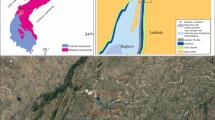Abstract
SIMS analyses have been carried out on clinopyroxenes, plagioclases and amphiboles of six gabbroic samples from Holes 921–924 of the Ocean Drilling Program Leg 153 sited in the MARK area of the Mid-Atlantic Ridge at the ridge–transform intersection, to investigate the rare earth, trace and volatile element distribution in the lower ocean crust during igneous crystallization and higher grade metamorphic conditions. The metagabbros underwent granulite to subgreenschist facies conditions through three main tectono-metamorphic phases: (1) ductile regime (750 < T < 1000 °C and P ≈ 0.3 GPa); (2) transitional regime (600 < T < 700 °C and P ≈ 0.2 GPa); (3) brittle regime (350 ≤ T < 600 °C and P < 0.2 GPa). Igneous clinopyroxenes show C1-chondrite normalized patterns depleted in LREE, and nearly flat for HREE. The rare earth and trace element distributions in igneous clinopyroxenes and plagioclases indicate that these minerals act as REE reservoirs, and comprise the main contribution to the overall rock content. The abundances in igneous minerals reflect the degree of fractionation of the parent liquids. In metamorphic clinopyroxenes recrystallized in anhydrous assemblages, the REE and trace elements patterns mimic those of the primary ones. Conversely, clinopyroxene re-equilibrated in amphibole-bearing assemblages shows a significant increase in REE, Ti, Zr, Y and V, a negative Eu anomaly, and slight decreases in Sr and Ba. An overall increase of REE and some trace elements is evident in hydrous assemblages, with preferential partitioning in the amphibole. It shows high Ti (18196–22844 ppm), LREE depleted patterns and LaN/SmN=0.10–0.33, LaN/YbN=0.10–0.30. Amphiboles from granoblastic assemblages show homogeneous patterns with no or a positive anomaly for TiN and negative anomalies for SrN and ZrN. Volatiles in amphibole are low, with Cl/F < 1; H2O% is significantly lower than the stoichiometric ratio (1.33–1.53%). The composition of the clinopyroxene and amphibole recrystallized in low-strain domains records evidence of incomplete re-equilibration, and element diffusion and partitioning is in part controlled by the textural site. The possible origins of the fluids involved in the metamorphic recrystallization are discussed: (1) remobilization from igneous amphibole; (2) exsolution from evolved melts; (3) introduction of seawater-derived fluids modified in rock-dominated systems; (4) injection of highly evolved hydrous melts during the metamorphic process.
Similar content being viewed by others
Author information
Authors and Affiliations
Additional information
Received: 6 September 1999 / Accepted: 6 March 2000
Rights and permissions
About this article
Cite this article
Cortesogno, L., Gaggero, L. & Zanetti, A. Rare earth and trace elements in igneous and high-temperature metamorphic minerals of oceanic gabbros (MARK area, Mid-Atlantic Ridge). Contrib Mineral Petrol 139, 373–393 (2000). https://doi.org/10.1007/s004100000147
Published:
Issue Date:
DOI: https://doi.org/10.1007/s004100000147




